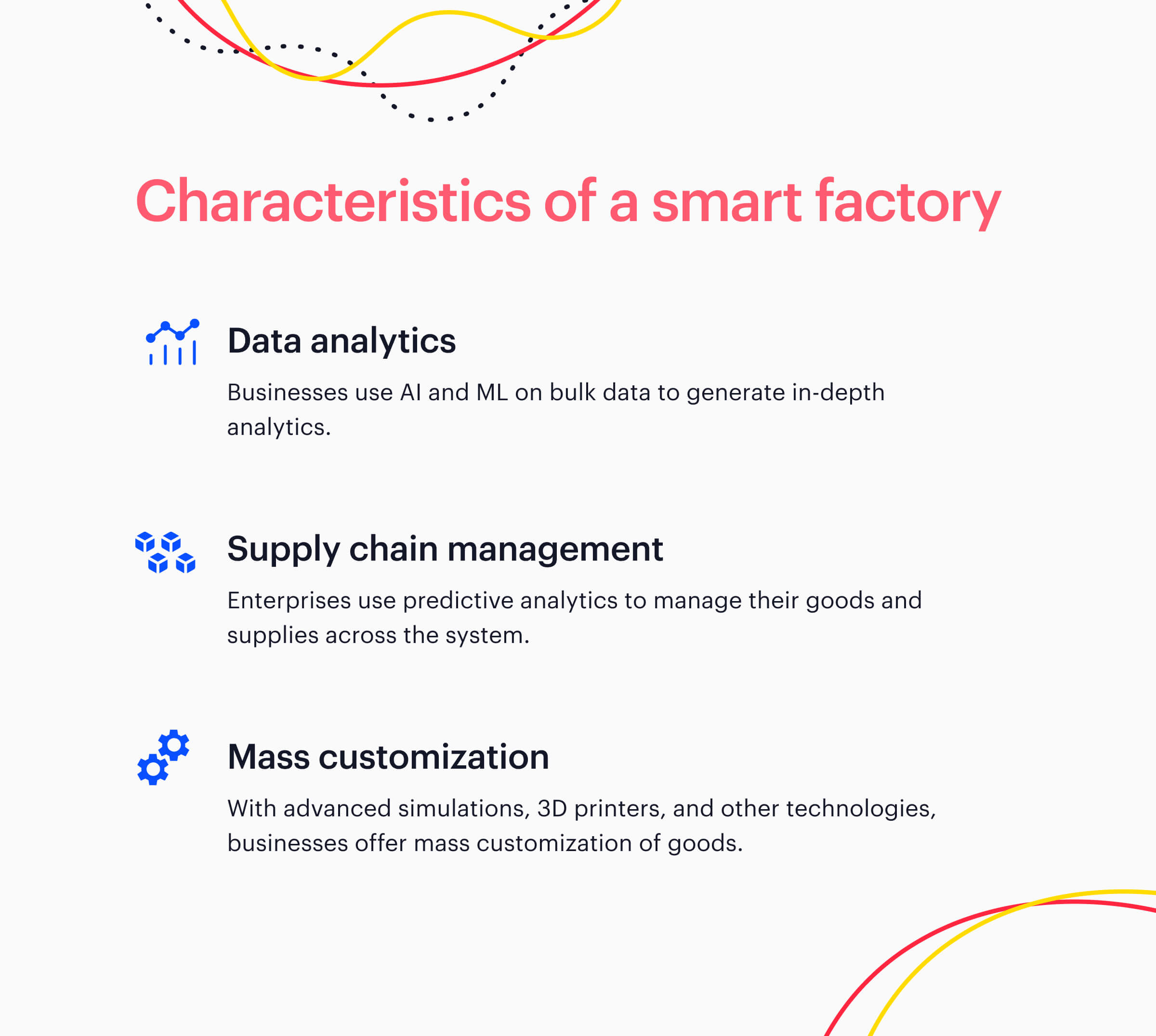Industry 4.0 – The next industrial revolution is here

Industries have evolved over time. This fourth phase of the industrial revolution focuses heavily on interconnectivity, real-time data, and automation of processes. Also known as smart industries, this new phase includes the Industrial Internet of Things (IIoT) and smart manufacturing.
The historical context of Industry 4.0
From water and steam power to powerful data analytics, our industries are going through the fourth phase of a historical revolution. Since 1760, industries have been going through constant changes and evolutions in how they function. Let’s have an in-depth look at the history of the industrial revolution.
First industrial revolution
From 1760 to 1830 in Britain, the first industrial revolution permanently changed human lives. The first revolution was characterized by the use of water and steam to power factories to mass produce goods, replacing animal and human labor. Machines took over manual labor and changed the way humans worked and lived.
Second industrial revolution
In the mid-nineteenth century, the world witnessed the advent of the second industrial revolution, introducing assembly lines powered by oil, gas, and electricity.. Steel production was on the rise during this period. Along with the industrial revolution, telegraphs and telephone became the media for communication.
Third industrial revolution
In the middle of the twentieth century, computers revolutionized the industry once again. . The world also witnessed vast advancements in telecommunication and the advent of data analytics. The event was the onset of the digitalization of the industries, where factories began to embed programmable logic controllers (PLC) into their machinery, facilitating data collection and automation in some manner.
The fourth industrial revolution (Industry 4.0)
Currently, we are in the middle of a fourth industrial revolution, also known as Industry 4.0. Automation of all operational processes is on the rise, and smart factories and machinery are coming into play. A vast volume of data collected by various sensors, analytics, and predictions helps businesses make more informed decisions. The precise data and analytics power industries to perform better and increase their capabilities in production while spreading value across supply chains.
The advent of these new trends in technology increases the flexibility of these industries, enabling the manufacturers to meet customer needs and seek an increase in their efficiency. By collecting immense data from their factory floors and combining them with operational data, businesses achieve greater transparency and heighten their decision-making capabilities.
The availability of high-end internet of things (IoT) devices backed with powerful artificial intelligence (AI) has led factories to achieve ultimate quality and top-notch productivity. Long gone are the days of manual inspections. Improved analytics insights help businesses cut down costs while reducing errors. Quality control personnel can supervise the manufacturing process from anywhere via cloud technology. With machine learning (ML) programs, manufacturers can detect errors and fix them on time, rather than waiting for expensive machinery to break down.
Industry 4.0 applies to all industries, including discrete manufacturing, process manufacturing, mining, oil, and gas.
Technologies that drive industry 4.0
Internet of things (IoT)
IoT plays a vital component in making factories smart. The business equips the machines on the factory floor with various sensors connected via the internet, letting them communicate with each other. The devices collect large volumes of data, which the system analyzes for multiple purposes.
Cloud computing
Cloud computing is the cornerstone of Industry 4.0, powering businesses to unlock the full potential of smart factories. The cloud creates a way to connect and integrate engineering, supply chain, production, sales, and services. The cloud makes it easier and more cost-effective to process the stored and analyzed large volumes of data. By venturing into the cloud, small to mid-sized companies can cut their upfront costs while availing the opportunity to scale with ease.
Artificial intelligence (AI) and machine learning (ML)
AI and ML leverage the huge volume of data collected using smart tech, not just on the factory floor but from all business processes. Using the data generated, AI and ML create precise analytics and insights that enable businesses to achieve automation, make informed decisions, and predict outcomes of particular situations. As per certain algorithms, the system can conduct predictive maintenance of expensive machinery, resulting in more uptime and unmatchable efficiency
Edge computing
As the demand for real-time operations is high, some data analytics must be done when the data is born, or rather, at the “edge.”. The latency time from data production to the response must be low. The time taken to send data from the machines to the cloud and back to the factory floor can be long, heavily depending on the network’s bandwidth. The response time is lower with edge computing, and the data stays closer to the source.
Cybersecurity
In this generation, where data is the new oil, the need for cyber security is a top priority. Though not many associate the manufacturing sector with cyber activities, data collection and storage attract malicious activities and attackers. When a factory opts to transform into a smart one, always keep cyber security a priority.
Digital twin
By digitally transforming their processes, manufacturers can create digital twins. The manufacturers build virtual models of their processes, assembly lines, factories, and supply chains by pulling data from IoT sensors and other devices connected to the internet. These digital twins help businesses test changes in their processes and find ways to minimize downtime or improve their capacity.
Characteristics of a smart factory

Data analysis for informed decision making
Manufacturers get a heavy volume of data via interconnected sensors. Using AI and ML techniques, the business conducts precise data analytics that helps them understand patterns and historic trends, facilitating informed decisions. The factories also use data from other parts of their organization like suppliers, distributors, sales, and warehouse managers to create deeper insights.
Supply chain management
A transparent and efficient supply chain system heavily influences the operations of the factory floor. The supply chain influences manufacturers to acquire their raw materials and ship the finished goods. With precise analytics and accurate data, they have better control over delivery times. For example, when a disruption in the assembly line occurs, the manufacturers can reroute or delay the deliveries to reduce costs. Companies can use predictive analysis to understand the arrival of raw materials or control the delivery of the finished products on time.
Mass customization
Customers look for customization of their goods. That’s exactly what smart factories do. With the availability of newer materials, technologies like 3D printing, and advanced simulation software, creating smaller batches of customized products is an easy outing. While the first industrial revolution was about mass production, industry 4.0 favors mass customization.
Advantages of the industry 4.0 model
Industry 4.0 covers all aspects of the manufacturing processes, including inventory management, scheduling, quality analysis, engineering, design, sales, and service. With this new industrial revolution comes an array of benefits.
Makes you more competitive
By adopting modern technologies, the manufacturers accelerate the processes happening on the factory floor and optimize their operations. With the same system and capabilities as the industry’s disruptors, industry 4.0 gives you the chance to be more competitive in the game.
End-user centric
Factory 4.0 enables the mass customization of goods. Factories can manufacture goods in small batches with frequent changes. Technologies like 3D printing and digital simulation reduce the prototyping costs and improve performance checks. The manufacturers can scale the number of versions of the products.
Makes the team more collaborative
Industry 4.0 boosts communication and collaboration between the workforce. People, including managers, executives, operators, and quality analysts, can leverage real-time data and intelligence to manage their daily responsibilities with ease.
Neutralize problems early
Industry 4.0 brings predictive analysis, which helps businesses understand an issue before it happens or can automate the service schedule. For example, with the data from a machine, the system can understand if the equipment underperforms or has a defect. The system can alert the manufacturer or notify for repairs before the expensive machine breaks down, thereby saving cost and time.
Lesser costs, more profit
The technologies that propel industry 4.0 optimize all processes happening on the factory floor and the manufacturer’s supply chain. The real-time data and valuable insights help businesses make faster and better decisions. With optimized processes and informed decision-making capabilities, the manufacturer can cut down their overall costs while increasing their profit margins. As a result, the manufacturer is capable of better handling their inventory.
A tease into the future
As the transformation of manufacturers by industry 4.0 is happening, the next industrial revolution is ongoing. Industry 5.0 will be all about robots and smart machines enabling humans to work better. Industry 5.0 will let people bring their creative side to work, while factories become more personalized and create a human experience for workers and customers.
Planning to transform your factory floor into industry 4.0? Let’s take a step further.
Case Studies
Let our work do the talking
Learn about the instances where we were able to create an impact, raising the bar on the standards we set for ourselves.

PiServe — Revolutionizing the versatility of technology in the corporate world
Curated Technologies. Design at Heart. Rapid business Transformation
Insights
The information technology times
Have a read on groundbreaking figments of imagination of the brightest minds that have been brought to life.
How can we help you?
Get in touch and let’s find out how we can curate our offerings to match your organization’s needs.
Get in touchSign up for our latest insights.
Never miss an insight. We’ll email you when new articles are published.
Subscribe.
Thanks for subscribing to PiServe Insights.
Please fill in the details.











